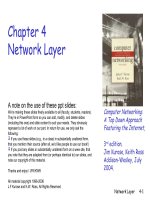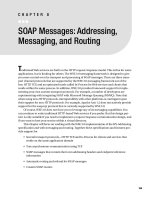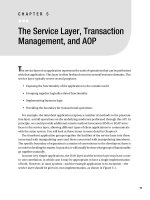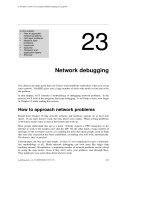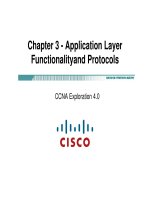Chapter 22 Network Layer: Delivery, Forwarding, and Routing ppt
Bạn đang xem bản rút gọn của tài liệu. Xem và tải ngay bản đầy đủ của tài liệu tại đây (1.99 MB, 83 trang )
22.1
Chapter 22
Network Layer:
Delivery, Forwarding,
and Routing
Copyright © The McGraw-Hill Companies, Inc. Permission required for reproduction or display.
22.2
22-1 DELIVERY
22-1 DELIVERY
The network layer supervises the handling of the
The network layer supervises the handling of the
packets by the underlying physical networks. We
packets by the underlying physical networks. We
define this handling as the delivery of a packet.
define this handling as the delivery of a packet.
Direct Versus Indirect Delivery
Topics discussed in this section:
Topics discussed in this section:
22.3
Figure 22.1 Direct and indirect delivery
22.4
22-2 FORWARDING
22-2 FORWARDING
Forwarding means to place the packet in its route to
Forwarding means to place the packet in its route to
its destination. Forwarding requires a host or a router
its destination. Forwarding requires a host or a router
to have a routing table. When a host has a packet to
to have a routing table. When a host has a packet to
send or when a router has received a packet to be
send or when a router has received a packet to be
forwarded, it looks at this table to find the route to the
forwarded, it looks at this table to find the route to the
final destination.
final destination.
Forwarding Techniques
Forwarding Process
Routing Table
Topics discussed in this section:
Topics discussed in this section:
22.5
Figure 22.2 Route method versus next-hop method
22.6
Figure 22.3 Host-specific versus network-specific method
22.7
Figure 22.4 Default method
22.8
Figure 22.5 Simplified forwarding module in classless address
22.9
In classless addressing, we need at
least four columns in a routing table.
Note
22.10
Make a routing table for router R1, using the
configuration in Figure 22.6.
Example 22.1
Solution
Table 22.1 shows the corresponding table.
22.11
Figure 22.6 Configuration for Example 22.1
22.12
Table 22.1 Routing table for router R1 in Figure 22.6
22.13
Show the forwarding process if a packet arrives at R1 in
Figure 22.6 with the destination address 180.70.65.140.
Example 22.2
Solution
The router performs the following steps:
1. The first mask (/26) is applied to the destination address.
The result is 180.70.65.128, which does not match the
corresponding network address.
2. The second mask (/25) is applied to the destination
address. The result is 180.70.65.128, which matches the
corresponding network address. The next-hop address
and the interface number m0 are passed to ARP for
further processing.
22.14
Show the forwarding process if a packet arrives at R1 in
Figure 22.6 with the destination address 201.4.22.35.
Example 22.3
Solution
The router performs the following steps:
1. The first mask (/26) is applied to the destination
address. The result is 201.4.22.0, which does not
match the corresponding network address.
2. The second mask (/25) is applied to the destination
address. The result is 201.4.22.0, which does not
match the corresponding network address (row 2).
22.15
Example 22.3 (continued)
3. The third mask (/24) is applied to the destination
address. The result is 201.4.22.0, which matches the
corresponding network address. The destination
address of the packet and the interface number m3 are
passed to ARP.
22.16
Show the forwarding process if a packet arrives at R1 in
Figure 22.6 with the destination address 18.24.32.78.
Example 22.4
Solution
This time all masks are applied, one by one, to the
destination address, but no matching network address is
found. When it reaches the end of the table, the module
gives the next-hop address 180.70.65.200 and interface
number m2 to ARP. This is probably an outgoing
package that needs to be sent, via the default router, to
someplace else in the Internet.
22.17
Figure 22.7 Address aggregation
22.18
Figure 22.8 Longest mask matching
22.19
As an example of hierarchical routing, let us consider
Figure 22.9. A regional ISP is granted 16,384 addresses
starting from 120.14.64.0. The regional ISP has decided
to divide this block into four subblocks, each with 4096
addresses. Three of these subblocks are assigned to three
local ISPs; the second subblock is reserved for future use.
Note that the mask for each block is /20 because the
original block with mask /18 is divided into 4 blocks.
Example 22.5
The first local ISP has divided its assigned subblock into
8 smaller blocks and assigned each to a small ISP. Each
small ISP provides services to 128 households, each using
four addresses.
22.20
The second local ISP has divided its block into 4 blocks
and has assigned the addresses to four large
organizations.
Example 22.5 (continued)
There is a sense of hierarchy in this configuration. All
routers in the Internet send a packet with destination
address 120.14.64.0 to 120.14.127.255 to the regional
ISP.
The third local ISP has divided its block into 16 blocks
and assigned each block to a small organization. Each
small organization has 256 addresses, and the mask is /
24.
22.21
Figure 22.9 Hierarchical routing with ISPs
22.22
Figure 22.10 Common fields in a routing table
22.23
One utility that can be used to find the contents of a
routing table for a host or router is netstat in UNIX or
LINUX. The next slide shows the list of the contents of a
default server. We have used two options, r and n. The
option r indicates that we are interested in the routing
table, and the option n indicates that we are looking for
numeric addresses. Note that this is a routing table for a
host, not a router. Although we discussed the routing table
for a router throughout the chapter, a host also needs a
routing table.
Example 22.6
22.24
Example 22.6 (continued)
The destination column here defines the network address.
The term gateway used by UNIX is synonymous with
router. This column actually defines the address of the next
hop. The value 0.0.0.0 shows that the delivery is direct. The
last entry has a flag of G, which means that the destination
can be reached through a router (default router). The Iface
defines the interface.
22.25
Example 22.6 (continued)
More information about the IP address and physical
address of the server can be found by using the ifconfig
command on the given interface (eth0).
